The biggest news of the day is the Dutch/Danish decision to supply F-16s to Ukraine:
As usual, buried within this “optimism” are a few inconvenient facts, like their insistence on a strict set of protocols being fulfilled before handing over the planes, which will likely not allow Ukraine to have the planes until well into 2024 at the earliest.
The total number remains in question as well, with some sources claiming 42 planes.
I want to re-iterate that even if this actually ends up happening—before Ukraine collapses or surrenders, that is—I view the delivery of such planes as a very good thing. I’ve said since the beginning that all the most advanced Western arms provide essential training to Russian forces, who need to learn how to fight against these systems for the sake of a potential future war against NATO proper.
That means Russian AD operators, fighter pilots, etc., will all get critical experience on dealing with one of NATO’s top aircraft, including registering their characteristics into their radar registries for enhanced identification purposes.
Such a rare opportunity to go up against and study these types of systems in a ‘low risk’ environment is crucial. It’s better to go up against them now, in Ukrainian hands and low numbers, while learning their secrets and weaknesses, than experiencing them for the first time in a full-fledged war against NATO where hundreds/thousands of them are deployed at the same time in a far more uncontrollable setting.
Sure it may seem callous to want Ukraine to have better/more advanced weaponry because the argument is that some Russians will lose their lives from this, but you have to see things in a broader view. It will save more lives in the long term, in light of a much larger future war, if they can master combating these systems now.
As for those continuing to wonder how Ukraine proposes to keep its F-16s safe, or how it currently does with its remaining meager airfleet, here’s a new quote from the Financial Times which sheds light on something I’ve been reporting repeatedly on:
Financial Times, citing sources:
"Ukraine is hastily moving its pilots and aircraft because of an increase in Russian strikes on targets in western Ukraine. Russian missiles have recently targeted air bases, runways, a pilot training centre and a fleet of bombers carrying Western Storm Shadow and Scalp missiles.
"Because of this, Ukrainian pilots are forced to constantly shuttle between dozens of airbases and commercial airports".
Meanwhile, the despairing article headlines continue to roll in:
The only notable change in the new spate of headlines is that they’re now demonstrating a newfound brazenness in actually naming specifics—what won’t be achieved, what should be done instead. The difference is, before they merely stuck to giving the obvious—the counter-offensive is not going well—but kept things ambiguous under the tactic of hoping people would still maintain belief in its ultimate success. If you vaguely say “it’s not going as well as planned” but don’t mention that the specific objective of reaching the sea, or Melitopol, etc., can’t possibly be completed, then people will keep hope alive.
But now, they’re outright naming the key objectives with the admission that they will not be achieved. One of the main reasons for this switch is that a new “leaked intelligence report” has made this determination:
The U.S. intelligence community assesses that Ukraine’s counteroffensive will fail to reach the key southeastern city of Melitopol, people familiar with the classified forecast told The Washington Post, a finding that, should it prove correct, would mean Kyiv won’t fulfill its principal objective of severing Russia’s land bridge to Crimea in this year’s push.
The grim assessment is based on Russia’s brutal proficiency in defending occupied territory through a phalanx of minefields and trenches, and is likely to prompt finger pointing inside Kyiv and Western capitals about why a counteroffensive that saw tens of billions of dollars of Western weapons and military equipment fell short of its goals.
But of course nothing in Washington “leaks” without a purpose. So you might be wondering, why the shift in rhetoric, what do they hope to accomplish? It seems that one of the reasonings is by clearly articulating the dire nature of the situation, they hope to steer policy into new escalatory directions. Whereas before their signals of alarm were perhaps more caveat or warning, now they’re prescribing actual directional changes.
In the above Newsweek article, the author offers an “innovative” solution to ending the war in Ukraine.
The author argues that, firstly, a “forever war” favors Putin and Russia, not Ukraine or the West, but they’ve discovered a way to “stick it to Putin” by ending the war abruptly and not giving him the “forever war” that he wants. They suggest to give Ukraine funding to continue operations up until July 2024, the date of the next big NATO summit. At the point of that summit, Ukraine should stop all offensive operations and then be given full entry into NATO.
This, they argue, would allow Ukraine to keep and consolidate whatever territory they’ve managed to win back by then, and would protect them from any further Russian advances by way of Article 5. This is no different than giving a divided Germany NATO status after WW2, they argue.
What’s most intriguing about this plan is that the author is actually none other than Democrat congressman Tom Malinowski, and it befits him to oh-so-conveniently militate toward a cessation of hostilities in July 2024, right on the eve of the U.S. presidential elections, whereupon Democrats will need all the help they can get. If a plan could be designed and packaged in a way where it can be sold as a major “victory” then certainly Democrats will attempt to drag it out until the eve of the election to try to use “Biden’s major Ukrainian victory” as a huge final hour boost.
The other intriguing thing is how it dovetails with Lukashenko’s new theory, which he gave during a recent interview, that Ukraine will be inducted into NATO on the basis of Poland occupying its Western territories. He doesn’t spell out the exact mechanisms by which he envisions this to happen, but merely the inference that NATO will have little room to reject Ukraine once a full-fledged NATO member has already politically merged with them.
Though he did impart his opinion that Ukrainians wouldn’t allow this:
Lukashenko believes that Ukrainians will not give Poland western territories “I think that the Ukrainians themselves will not allow it. Zelensky is moving towards this: you made some kind of decision there that either Polish policemen or civil servants are already almost equated with Ukrainian ones. Moreover, units have already been created in Poland - a military unit of assistance to Ukraine. If they come in, you won't turn them out, because the Americans are standing behind Poland. Well, there will be Polish territory. Why not accept them into NATO? This will be Polish territory. They will lead to it. Therefore, everything is prepared for this. For us, this is unacceptable, as well as for the Russians. In order not to fragment Ukraine and stick it in parts somewhere, we must stop here and do it in such a way as to preserve this integrity of Ukraine. And then talk. You see, this is the first thing you need to do. This is what you need, Ukrainians,” Lukashenka said.
By the way, given Malinowski’s proposal above, as well as the recent one by NATO’s chief of staff Stian Jenssen who likewise proposed a ‘land for peace’ settlement, two things happened. Firstly, NATO was forced to apologize after enraging Ukraine:
And secondly, Ukraine is now attempting to codify into law the inadmissibility of settling the conflict by way of any territorial concessions whatsoever. Many deputies put forth a bill into the Verkhovna Rada that would legally oblige Ukraine to “go to the end” and would constitutionally not allow any concessions. The “end” would mean 1991 borders, as per the written bill.
Zelensky even gave a smug answer that the only territorial concession he’s willing to negotiate for NATO entry is the exchange of Russia’s Belgorod region:
But getting back to the main proposals: the other side, argued by Edward Luttwak in a new Die Welt article, says that the only way Ukraine can win is by going “total war” mode, a complete societal mobilization of 3 million bayonets.
💥 Ukraine needs to mobilize 3 million people to succeed in the conflict with Russia. So says an article in Die Welt.
"There is only one way forward: to wage the war with the seriousness befitting a national liberation struggle. Ukraine's population has shrunk, it is true, but it is still more than 30 million people, so the total number of armed forces could be as high as 3 million. With such a military force, Ukraine could win battles and liberate its territory the old-fashioned way - in a war of attrition, like most European wars of independence," the author believes.
"As for the Russian economy, the news is grim, but not grim enough. The war will not end because of Russia's economic capitulation," the author says, pointing out that unlike China, Russia is able to provide its own food and fuel, and generally produce almost everything it needs.
Until the last Ukrainian! It seems like Die Welt tries to impose a well-known Nazi concept of "Totalen Krieg" on modern Ukraine.
And it seems, ironically enough, that Zelensky has recently signaled interest more in this plan rather than the opposing one. Twice now in the past week or two alone, Zelensky has eerily posted videos chastising Ukrainian society for ignoring the war and imploring that “everyone” should be assisting in the war effort in one way or another.
Other Ukrainian officials have similarly began to signal such a direction. I recently posted one such official who stated that “all Ukraine” may have to be mobilized in the future.
The other ‘well-timed’ release making the rounds was the new NYTimes article with the “bombshell” revelation that over 500k casualties have been suffered in the war thus far:
Of course, as usual they couch these figures with the fact that it’s Russia still taking the lion’s share of the losses:
Russia's military casualties are approaching 300,000, including as many as 120,000 deaths and 170,000 to 180,000 injuries, the newspaper reported. Ukrainian deaths were close to 70,000, with 100,000 to 120,000 wounded, it added.
But we know in reality this is their way of signaling Ukraine’s losses without causing too much of a panic. If they had merely come out and said that Ukraine has 200k total casualties, it could overturn the apple cart. The Russian figures are completely made up nonsense, the Ukrainian figures are likely trimmed down quite a bit, but at least they’re beginning to slowly leak the truth to the public. Acknowledging 190-200k total casualties for Ukraine is a start, and is their way of very gradually conditioning the public for the harsh realities to follow.
Discussion continues to turn to what comes next. More and more we’re hearing reports that Ukraine is simply terrified of stopping active offensive operations, no matter how costly they are in losses, because they suspect that Russia may launch its own offensive as soon as it senses Ukraine weakening and backing off. Thus, they believe that they’re fending off the coming locomotive by distracting it with their own flailing, but ultimately meaningless, actions.
The truth is though, it’s easy to see how the conflict can be a very confusing one for the uninitiated. Both sides claim to be winning and inflicting massive casualties on the other, but the actual battle lines have not changed much in many months. It’s a sort of Schrodinger’s War run on the power of belief and blind religious faith in one side or the other. And while I know the truth of what’s really going on behind the smokescreens, I don’t claim as my mission the intent to ‘convince’ my followers of the truth of one side or the other. To actively vie for ‘convincing’ people would appear a bit desperate, and I think the truth is self-evident enough that it will come out in time, such that I don’t need to go overboard in proselytizing anyone, apart from merely reporting the facts as I see them. But there are many things difficult to report because they cannot be reduced down to bite-sized morsels but are infact the byproduct of years of experience and subtle understanding of reading between the lines and proper analysis of information.
At the end of the day, there’s only one side from whom we’re seeing massive cemeteries being tracked from space due to their size, and daily urgent calls for more body bags, coffins, graves, crematoriums, etc.
Take this new AFU order for instance:
🇺🇦The order of the commander of the 123 brigade of Territorial Defense of Ukraine appeared on the web.
So, according to this document, the commander of the A-7052 unit (123 brigade of the TERO) ordered his deputy in the rear to get mobile crematoriums, and the battalion commanders to collect receipts from the AFU militants to be cremated, writes the Kherson Bulletin.👌
Apparently, the mobilization is going "according to plan" and no one wants to bother with transporting the bodies of the AFU militants, but simply burn them and scatter the ashes on the field.
Or this Ukrainian volunteer begging for body bags for a number of AFU battalions:
Also, from one of the ABC articles whose headline I posted earlier, we’re told that American mercenaries in the AFU have reported their units taking 85% casualties:
One of the men, a former U.S. soldier from Texas who goes by the callsign "Tango," said his unit of "dozens" of men took "85% casualties" and that two of their comrades were killed when the team was ambushed whilst advancing into Russian-occupied territory. Forty percent of the unit was so badly injured they were rendered "combat ineffective," he said.
It goes on and on:
A third mercenary, from an unidentified Western nation, told the network that he had been seriously injured in the early days of the counteroffensive, and that around 80% of his battalion had since been wounded.
Not to mention the fact they praise Russian professionalism:
"It was definitely a very professional force that we were fighting against," the U.S. army veteran from Alaska said.
Ring a bell?
But all that said, I can see how the current situation may very well look like a ‘stalemate’ from the outside, and I don’t blame anyone for thinking it so. On the surface it very much appears a stalemate, but looking past the smokescreens we can see one side is clinging for survival while the other merely bides its time and gets stronger by the day.
In his new interview with Ukrainian dissident journalist Diana Panchenko, Lukashenko made a few revealing statements, one of which he even prefaced with “I don’t know if I should be telling you this”, implying the intimation of a state secret:
He states that Russia has raised a 250,000 strong volunteer force, which is larger than the entire force Russia is currently using in the war. Recall I’ve been the only analyst accurately tracking the true troop counts on the front, and have repeatedly stated that Russia started the war with only 70-80k men, not the “250k” everyone thought.
Presumably Lukashenko here is referring to Shoigu’s new army, which Medvedev recently reported had already been 230k+ in number as of early August.
More importantly, he seems to believe Russia will use this huge new army (which grows by the day) in active combat to completely eviscerate the remainder of Ukraine. It’s possible—we don’t know yet the exact intention behind the creation of this army, besides, for now at least, being a reserve to deter NATO aggression.
But there have been other indications they may use these forces, though it’s difficult to say. There was even rumor that Putin is considering completely demobilizing all the 300k previously mobilized forces from September 2022 and replacing them with the newly raised men. Some may think this is crazy, but it would be a huge morale boost to men who’ve now been fighting for almost a full year to know that they are going home to their families. It will give other servicemen something to fight for, knowing that their military term will be limited and not “until death.” Plus, many would stay on anyway and giving them the option of going home would merely be an added morale boost.
This likely won’t happen though. But now there’s talk on the pro-Russian side of what kind of offensive we may see. One theory that’s gotten buzz is this video from WeebUnion who very intricately outlines what he believes will be Russia’s war-ending offensive, with Wagner coming down from the north:
It’s interesting to think about, but personally I don’t rate the chances of it as high, at least for now. One of the reasons is that I’m not sure that Russia will ever launch a “big arrow” offensive of this magnitude ever again because the high-tech nature of the modern war—particularly in the second half of the SMO thus far—has evolved to a place where I’m not sure either army can make those WW2-style pushes most people have come to expect. I think Russia’s tactic for the foreseeable future will continue to be the slow pressure on all fronts to wear down the AFU by way of artillery, then advancing only in places where it’s most agreeable.
Some think you can’t advance without major risk, barreling straight into enemy held territory—but that’s not true. We see from both sides presently that artillery and drone warfare has gotten accurate enough that artillery alone (corrected by drones) is often enough to dislodge an enemy from a settlement (currently happening in Rabotino for the AFU and in Sinkovka, near Kupyansk, for Russia), allowing friendly troops to move into it while minimally contested.
The fact is, in previous eras of war, the type of ISR we see today simply didn’t exist, which meant that all advances/offensives had to partially if not majorly rely on brute forcing your way into a contested area. Sure, there was recon-by-fire and other forms of recon which allowed you to get the gist of enemy positions and concentrations. But it’s nothing like we see today, where every enemy position down to the individual troops can be pinpointed in a given sector.
Thus, what we’re seeing in this modern style drone-assisted war is that advances can in fact be incrementally made by way of allowing artillery to clear your path very gradually, then moving into the vacated area.
I’ve written on it before, but one tactic both sides are currently using is simply hammering the enemy’s positions to such an extent that all defensive structures have been destroyed to the point where the troops lack any cover and are forced to retreat. Meaning, their trenches, dugouts, fortifications, are all blasted apart such that they become unusable. And since you can’t dig trenches in an active contact line, having no recourse, they have no choice but to retreat to the 2nd echelon line 3-5km back. The advancing force then moves up and rinses and repeats on this new line and continually forces you back.
Of course, one can argue that this isn’t much different than even WW1 warfare. Sure, they didn’t have the same ISR resultant accuracy, but they made up for that with sheer number of munitions expended, and yet there were stalemates for years when neither side could move. I think one of the differences is the sheer density of troops is much lower in Ukraine and oddly enough—as many have pointed out—the quality of trenches actually pales in comparison to WW1 designs. Most Ukrainian trenches would have gotten their builders court martialed in WW1, crude earthworks incomparable to the standardized and meticulously constructed examples from WW1:
Much of Ukraine’s trenchworks are just crude dirt walls that take one artillery blast and crumble, burying everyone inside. Compare WW1 trenchworks to this.
Incidentally, for those interested, one historian believes the 1944 battles in the hedgerows and fields of Normandy are a far better comparison to the current Ukrainian conflict.
Either way, there’s a continuation of rumors about Ukraine needing a mass new mobilization this fall/winter as more and more key officials articulate their belief that Russia is preparing for a mass Spring 2024 offensive.
💥🇷🇺 💥Russia is preparing a big offensive.
The Newsweek edition has quoted a source close to the Ukrainian government as saying that the Russian army is preparing a new offensive for next spring.
The publication said that the Ukrainian authorities and commanders "very likely expect the Russians to start preparations in autumn in order to make a big push in spring".💥💥💥
Interestingly, there was even rumor that Ukraine’s general staff wants Zelensky to begin mining Odessa and Nikolayev regions, but he’s afraid as doing so would signal that Ukraine is failing:
The General Staff of the Armed Forces of Ukraine is trying to convince Zelensky to start mining the Odessa and Mykolaiv regions, as well as build defensive redoubts , as an attempt of a counteroffensive of the Russian Armed Forces in this direction is expected in the spring of 2024.
Zelensky is still against it, as it will be an admission that Ukraine is going on the defensive and losing the initiative, which will further undermine the morale of the rear. While society is holding on to the "straw" that the APU is about to come out to the Crimea. If you start building defensive redoubts, it will confirm the message that everything is much worse than even written in alternative Telegram sources.
Another development vis a vis the new narrative of preparation for Russia’s spring 2024 offensive is that U.S. and the West are in worst shape than ever ammunition-wise, and want to use the winter as a recouping period, where conflict intensity, and therefore ammo expenditures, will be low.
🇺🇸🇺🇦🇷🇺🇨🇳The US Department of Defense is waiting for winter to come, hoping for a reduction in the intensity of hostilities in Ukraine in order to be able to increase the production of ammunition and maintain stocks of military products, the New York Times reports, citing sources.
"Although Ukraine's summer counteroffensive has been going on for only months, defense officials are already looking towards winter, when a potential lull in the battle is possible ... allowing the United States and allies to "catch up and maintain" production," the newspaper writes.
Officials admit that while the fate of the counteroffensive rests on the West's ability to satisfy Kiev's "staggering hunger" for artillery shells, the challenge for the United States is to be able to secure its own security in the event of potential conflicts with Russia or China.
Among the problems are also the bureaucratic delays on the part of the Pentagon, because of which defense contracts are concluded gradually. The agency has so far managed to finalize transactions by only 41% of the total amount of funds allocated for the production of weapons for delivery to Ukraine.
This follows a Washington Post report that a shortage of materials is leaving the Pentagon scrambling for supplies to sustain its shell production.
Recall my reports a while back about how the U.S. can no longer even produce certain types of explosives, relying on outside suppliers, one of the main ones ironically was in Donbass and subsequently taken over by Russia:
A shortage of raw materials – particularly the explosive TNT, which the US no longer produces – has hampered the Pentagon’s efforts to restock its own arsenal, which has been severely depleted by its support for Ukraine. Washington currently obtains much of its TNT from Poland but has been searching for new suppliers, including in Japan, after losing production partner Zarya when the region where the factory was located voted to become part of Russia in last year’s referendum.
Meanwhile, workers at the Storm Shadow factory in Britain are going on strike over low pay:
Interestingly, I haven’t heard about any more ammunition problems from the Russian side ever since Prigozhin ignominiously exiled himself.
So, given these rumblings, what are we to make of the near future? Russia will continue pressing in the north, and there’s a fair chance they can recover most, if not all, of the territory east of the Oskol river by the end of this year. The latest breaking updates show that they’re beginning to surround Sinkovka, and some reports even claim all AFU units have fled the town and retreated:
Meanwhile, here’s an illustration of the movements from the eastern flank. That’s Kupyansk in the center, the animation is showing Russia’s progress in the past few weeks from the east and north:
This area is quickly collapsing—relatively speaking—for the AFU, and there’s no strong reason to believe that Russia won’t push them fully out by the end of this year, at least in the north portion. We reported last time about evacuations being issued for dozens of settlements in this area by Ukrainian regional authorities. Ukrainian wives are frantically begging for help on Telegram, as hundreds of their husbands are going missing after being hastily transferred from elsewhere in Donbass to plug emergency holes:
The question then will be for next year: will Russia attempt to cross the river or insert forces from the north, in the Kursk region, to come down into Kharkov and begin evicting AFU southward. One interesting update on this regard is there’s now been reports that Russia has bombed one of the two main bridges inside Kupyansk itself, which may be indicative of the acceleration of events.
🇷🇺🇺🇦 There is information about the destruction of one of the crossings across the Oskol River in Kupyansk. According to local channels, the movement of cars along it is currently impossible and they are sent to a detour.
Recall that Kupyansk, controlled by Ukraine, which is being attacked by the RF Armed Forces, is divided into two parts by the Oskol River and connected by two bridges - road and rail (on the map below). After the first bridge of the Armed Forces of Ukraine was blown up, a crossing was built near it, if the information about its incapacitation is correct, this will hit the logistics of the Armed Forces of Ukraine in Zaoskolie hard.
It is noteworthy that almost exactly a year ago Kupyansk was abandoned by the Russian army precisely because of the destroyed bridges . This made it impossible to supply the city. It looks like the APU is now facing the same problem.
This remains unverified though, at least insofar as photo/video evidence.
Elsewhere, the situation remains mostly unchanged. The elite AFU 82nd, as part of the ‘Maroon’ group, continues trying to storm Rabotino with its Strykers. They’ve managed to knock Russian troops out of several positions but so far rumors of their taking Rabotino have proven false. Photos of 2 newly destroyed Strykers are testament to the battles.
There were rumors that U.S. command has become irate with Zaluzhny and Ukrainian command in their choice of splitting up the AFU forces in a vain attempt to retake Bakhmut. U.S. command apparently wanted Ukraine to go “all in” on the southern front, but Zelensky/Zaluzhny remain obsessed with vindicating their symbolic loss in Bakhmut. One can see that NATO’s top generals and planners are working hand in glove with Ukraine on their offensive and thus feel attached to the plans. From Admiral Tony Radakin’s (Chief of Defense Staff—the head of the British Armed Forces) official account two days ago:
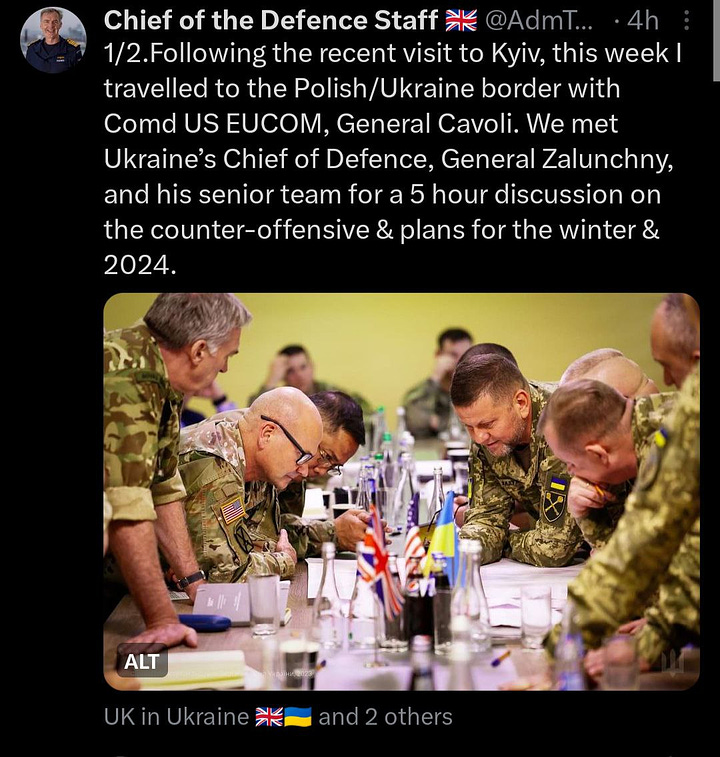
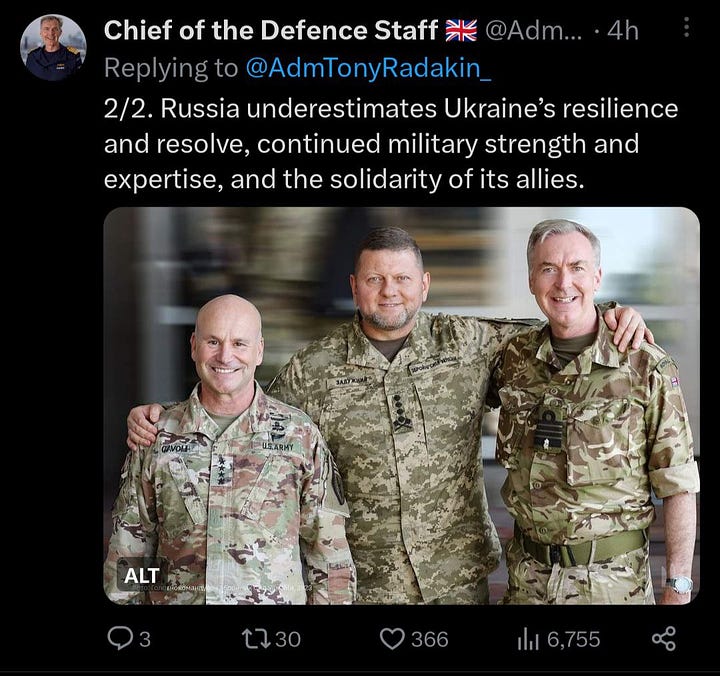
The reason is likely that Ukraine smelled blood after Wagner was forced out, thinking that Russian mobilized replacements would be comparatively weak and would fold under the onslaught of seasoned AFU troops. Unfortunately for Ukraine, that didn’t happen and Russian forces continue not only defending the area but even incrementally gaining territory around Klescheyevka recently.
However, not all such attempts go well. As a demonstration of the lesson of this conflict—in that, going on offensive typically results in massive losses for anyone—today Russian forces tried to expand even more by capturing a new height at the northwest edge of Klescheyevka, and they were repulsed with losses of several armored vehicles, as seen below:
Though I want to emphasize this isn’t a normal occurrence, and the above represents the Russian side’s largest such wipeout in many weeks.
This is precisely the reason why I said big arrow offensives with major armored “maneuver groups” striking out is not likely to succeed in such peer conflict, where every approach is mined, every corridor is overwatched with advanced modern ATGMs, and every push is seen in advance by omnipresent drone/satellite ISTAR systems, allowing the enemy to move appropriate defensive reinforcements into the sector to counterattack your push long before you even attempt it.
Apart from that, as I said last time, things are in a bit of a lull right now, so developments will feel quite samey and unremarkable. Ukraine tries to paper over the gaps by continually launching terror attacks or other feeble one-offs in an attempt to keep headline control but in the grand scheme of things, they don’t amount to anything. It’s why I hardly bother even reporting on the small occurrences and drone strikes—they really have no effect on the conflict.
The last general thing I’ll say is that, for now it appears both sides are sticking to maximalist goals. I already enumerated earlier how Zelensky is even trying to codify it into law, so no one in Ukraine can even think about ‘peace for land’ proposals and concessions. Meanwhile, on the Russian side Medvedev yesterday once more reiterated his maximalist projections, which could perhaps be indicative of the sentiment of all Russian elites, at least the patriotic ones. Here’s a translation of the firebrand screed—pay attention to the bolded portions:
The defeat of the West in the Ukrainian direction is inevitable.
And let their leaders, who have forgotten about their own citizens, shout with each other that they will support the stubs of the Square with weapons and money for as long as it takes. They will train soldiers for the Kyiv meat-packing plant, they will restore the ruins of the dying economy of the Bandera regime. Will maintain insane sanctions against Russia. It won't help. Why?
For them, this is a strange war in which people who are strangers to them are dying. And although they do not feel sorry for them, the West will never go beyond the fact that it will begin to harm its interests too much. No matter how loudly he laments at his summits and at the UN. Someone else's war sooner or later becomes boring, costly and irrelevant.
And for us it is a tragedy involving our people. This is an existential conflict. War for self-preservation. Either they or we.
Some time will pass. Western authorities will change, their elites will get tired and beg for negotiations and a freeze on the conflict. Any counteroffensive will fizzle out. The dead will be buried, the wounds will be licked.
But we must not stop until the current, inherently terrorist Ukrainian state is completely dismantled. It must be destroyed to the ground. Or rather, so that even the ashes from it did not remain. So that this abomination could never, under any circumstances, be reborn.
If it takes years or even decades, then so be it. We have no choice: either we will destroy their hostile political regime, or the collective West will eventually tear Russia to pieces. And in this case, he will perish with us.
Nobody needs this.
Therefore, the only way is the complete disposal of the state machine of a hostile country and absolute guarantees of loyalty for the future.
They can only be given by Russia's control over everything that is happening and will happen in the territories of the former Bandera state. And we will achieve it.
He’s saying that Russia can only get a proper guarantee from Ukraine by completely destroying the ruling regime and conquering and controlling all of Ukrainian territory.
On the heels of that, Lavrov too stated that the West’s recent flurry of ‘peace proposals’ is merely cover for wanting to rest and re-arm Ukraine for further conflict:
“We regard the Westerners’ hypocritical calls for talks as a tactical ploy to buy time once again giving the exhausted Ukrainian troops a respite and the opportunity to regroup, and to send in more weapons and ammunition,” Lavrov said, adding that “this is the path of war, not a peaceful settlement process.”
He’s therefore signaling that peace talks are not possible and Russia is sticking to accomplishing its military objectives, a fact that is bullish for Russia’s aims. It seems all of Russia’s officials are on the same page, and only the rare liberal “oligarch” has agitated for stopping the SMO.
And by the way, speaking of which, since many people still think Russia or Putin is somehow “controlled by the oligarchs”, there was another interesting update in that regard. News hot off the press from today goes as follows:
Russia is now prosecuting its literal richest billionaire, a guy who was in cahoots with another top oligarch who’s already been imprisoned since 2019, as per the article. Please name me a single top billionaire that’s been imprisoned or prosecuted in such fashion in the U.S. This would be the equivalent of Bezos or Bill Gates being prosecuted for corruption—something that’ll never happen in the U.S.
\
Let’s move onto some last sundry updates.
The biggest unrelated news is that the much-heralded Russian Luna-25 lunar lander we were putting great hopes in has unfortunately failed and crashed to the moon. There’s no two ways about this—it’s a big blow to the Russian space program and shows that they have not yet crawled out of the post-USSR mire.
With that said, for some context: these lunar landings are extremely difficult and even Japan’s recent attempt was a failure, and this is a nation most consider to be “the most advanced” in such things.
India’s Chandrayaan-3 lander is now scheduled to make its attempt within days and could oneup Russia’s effort, but it must be remembered that India’s own previous Chandrayaan-2 lander likewise failed and crashed into the moon as well.
But according to one report, Russia’s mission was not a total failure. There were two portions of it, and some successful tests were carried out from lunar orbit. But the second stage involving a lander actually touching down on the moon did not go as planned.
From Annanews:
What did Luna-25 manage to do?
After the hard landing of "Luna-25" on the natural satellite of the Earth, comments appeared on the Web about the "failure" of the lunar mission. The station ceased to exist and could not find water on the moon.
It is difficult to call what happened a failure. This serious step in the development of our space program brought closer the sending of cosmonauts to the Moon.
During the flight, several activations of the IKI RAS equipment were carried out. Here are just some of the results.
▪️In the energy spectrum of gamma rays, the ADRON-LR neutron and gamma spectrometer registered the most intense lines of chemical elements of the lunar soil.
▪️For the first time in the orbit of the Moon, the ARIES-L ion energy-mass analyzer is turned on, designed to study the near-surface ion exosphere in the subpolar region of the Moon. The data allowed us to choose the optimal mode of operation of the device.
The PML device, designed to detect microparticles levitating near the surface of the Moon and determine the parameters of the surrounding plasma, has registered a micrometeorite impact. Most likely, the micrometeorite belongs to the Perseid meteor shower, which Luna-25 managed to successfully cross during the flight to the Moon.
▪️According to the results of processing two frames of the Moon imagery made by the landing cameras of the STS-L system, a binding was made to a digital elevation model. This technology will significantly improve the accuracy of knowledge of the orbit of spacecraft.
▪️The images show the Zeeman crater. In the list of the twenty deepest craters of the southern hemisphere of the moon, he is in third place. It has an unusual size ratio: diameter - about 190 km, depth - about 8 km. His education is associated with a very strong blow.
Detailed photographs show that the bottom of the crater is dotted with smaller ones. This happens if part of the substance ejected upon impact fell back and created numerous small “potholes”. These formations are interesting from the point of view of lunar geology.
The editors and readers of ANNA NEWS wish the Roscosmos team success in preparing Luna-26.
Another expert chimes in with a good point about how space is costly and many failures result in a single successful mission of this kind, even dating back to the USSR period, so Russia must continue pushing ahead:
Space is expensive.
Soviet experience shows that you need to let a launch and often. From 1958 to 1976, 45 Soviet AMS were launched to the Moon, 31 launches ended in failure for various reasons – from a launch vehicle accident to errors already in the Moon's orbit. Those of them that fell at the launch due to the launch vehicle accident remained on the list under the names "E-# number #", those that entered Earth orbit received the designation "Cosmos-###" as artificial satellites of the Earth, those that were able to fly to the Moon received lunar the numbering was "Moon–##", but even at this stage not everyone was successful - accidents occurred both due to defects in brake engines and due to errors in management.
Moreover, the percentage of failures remained high in the later stages. If we take the third generation of Soviet lunar AMS, E-8, then from 1969 to 1975, 16 stations were launched. There were six successful attempts, one was partially successful, nine ended with the loss of the devices.
Three E-8 carriers of "Lunokhods", in 1969, 70, 73. The first launch was unsuccessful – the loss of Proton at the 52nd second of the flight, two became the Luna-17 and Luna-21 missions, bringing Lunokhod-1 and Lunokhod-2 to the surface of the Moon, respectively.
Two E-8LS – heavy satellites of the Moon in 1971 and 1974. Both launches were successful, Luna-19 and Luna-22 entered the lunar orbit. But the orbit of Luna-19 turned out to be uncalculated, which is why the mission can be considered only partially successful, and Luna-22 worked out its own by sending a series of television panoramas of the Moon, which greatly helped in solving the problems of the moon scoopers.
And there were 11 "moon scoopers". E-8-5 and E-8-5M are stations for the delivery of lunar soil. They were launched from 1969 to 1976, three were successful – "Luna-16", "Luna-20", "Luna-24".
Three more – "Luna-15", "Luna-18", "Luna-23" – failed during landing, but received numbers because the media managed to report the launch.
Two failed at the stage of operation of the upper stage and entered near-Earth orbit as Kosmos-300 and Kosmos-305.
And three remained under the indexes E-8-5 N 402, 405, 412 – without entering orbit.
Space is expensive. And if you stop "because it doesn't work out", it will be even more expensive – the probability of an accident after a long break is always higher.
As evidence of the above, some have compiled a list of total launches of the lunar program; you can see that it is riddled with failures with the odd significant success:
To understand the situation, Kaluga 24, together with specialists, studied the materials of the Space Research Institute of the Russian Academy of Sciences and collected the main milestones of the domestic lunar program:
1958 - Luna-1A, 1B, 1C - accidents,
1959 - Luna-1, flyby at a distance of about 5,965 km from the surface of the Moon and entry into a heliocentric orbit,
1959 - Luna-2A emergency;
1959 - Luna-2, the first station on the surface of the Moon,
1959 - Luna-3, the first photographs of the far side of the Moon;,
1960 - Moon, E3-1, emergency,
1960 - Luna E3-2, emergency,
1963 - Luna-4C,4D, emergency,
1963 - Luna-4, upper stage failure, flyby of the Moon,
1964 - Luna E6-5, emergency (did not start),
1964 - Luna E6-6, emergency (remained in earth orbit),
1965 - Cosmos-60, emergency,
1965 - Luna-5, emergency (crashed on landing),
1965 - Luna-6, upper stage failure; flyby of the moon
1965 - Luna E6-8, upper stage failure; the device remained in Earth orbit,
1965 - Zond-3, successful photography of the lunar surface; maintaining radio communications up to a distance of 153.5 million km,
1965 - Luna-7, crashed on landing,
1965 - Luna-8, crashed on landing,
1966 - Luna-9, the world's first soft landing on the moon,
1966 - Cosmos-111, upper stage failure; the device remained in Earth orbit,
1966 - Luna-10, entering the orbit of the moon, the world's first artificial satellite of the moon,
1966 - Luna-11, entering the orbit of the moon,
1966 - Luna12, orbiting the moon and photographing the surface,
1966 - Luna-13, soft landing on the moon,
1966 - Cosmos-146, another entry into the orbit of the moon,
1967 - Cosmos-154, upper stage failure; the device remained in Earth orbit,
1967 - Cosmos-159, upper stage accident,
1967 - Zond-4A, accident,
1967 - Zond-4B, accident,
1968 - E-6LS112, accident,
1968 - Luna-14, communication establishment,
1968 - Zond-4, accident,
1968 - Zond-5A, accident,
1968 - Zond-5, the first living creatures reached the orbit of the Moon and returned to Earth,
1968 - Zond-6, accident,
1969 - Zond-7A, accident,
1969 - Lunokhod-0, accident,
1969 - 7K-L1S, accident,
1969 - Luna-15B, accident,
1969 - 7K-L1S, accident,
1969 - Luna-15, loss of communication during landing,
1969 - Zond-7, flyby of the Moon and return to Earth,
1969 - Cosmos-300, remained in Earth orbit,
1969 - Cosmos-305, accident,
1970 - Luna E-8-5 405, accident,
1970 - Luna-16, landing on the moon, sampling and return of soil to earth,
1970 - Zond-8, flyby of the moon and return to earth,
1970 - Lunokhod-1, landing of the first lunar rover on the surface of the Moon,
1971 - Luna-18, crashed while landing on the moon,
1971 - Luna-19, entering a lunar orbit for mapping the Moon and exploring the lunar space,
1971 - Luna-20, landing on the moon and delivery of soil to earth (second already),
1972 - Lunokhod-2, soft landing, worked on the surface of the Moon for 378 days,
1974 - Luna-22, entering the orbit of the moon, mapping,
1974 - Luna 23, capsized on landing,
1976 - Luna-24, landing on the moon, the third delivery of soil to earth.
So in the spirit of perseverance, Russia already has a Luna-26 in the works for 2027, with Luna-27, 28+ planned as well. For those of the scientific/engineering/aeronautical extraction who want a more detailed explanation of what possibly went wrong, you can auto-translate this account.
Next:
Readers have previously pointed to continued concerns that Russia might be getting ‘outgunned’ in the artillery counter-battery fight in some way. Here’s a new video of an American AN/TPQ-36 counter-battery radar being destroyed by Russian Lancet on the Artyomovsk/Bakhmut front:
As I previously mentioned, there is at least a couple of these destroyed per month, whereas there hasn’t been any Russian Zooparks destroyed recently. To accompany this, there was an interesting update about how Russia’s artillery successfully drove out their counterpart in the same region:
An interesting note from Raccoon from Kherson on counter-battery work:
The successful work of our gunners forced the Armed Forces of Ukraine to drag Western-made artillery systems to a distance inaccessible to our artillery. Long-range self-propelled guns are located at a distance of 33 km from the LoC, they work mainly along the first line and attacking Artemovsk itself. This complicates the work for our artillery.
Under the prevailing conditions, the most effective counter-battery weapon is now the Lancet . It works in the current conditions at a distance of up to 40 km, and warhead modifications allow you to destroy lightly armored self-propelled guns.
The militants are trying to approach our positions only with infantry. Attacks with the support of armored vehicles now occur near Artemovsk every one and a half to two weeks.
This is the second time recently that I’ve read about Russian artillery beleaguering their Ukrainian counterparts so as to force them to retreat a great distance, from which:
they are far less accurate, and can only use specialized shells, which are far less numerous
they can only shoot at the exact contact line but can no longer reach Russia’s own 2nd/3rd echelons or “rear” areas
But as with everything, when Russia is doing something well, it’s forgotten or swept under the rug with the rationale of: “Well, that’s what Russia is supposed to be doing!”
For instance, many cried about Ukraine developing a tiny “beachhead” in the Cossack Camps on the left bank of the Dnieper in Kherson. But now, Russia has succeeded in completely cleansing the area and fully expelling the AFU, uncovering huge caches of left-behind materiel in the process:
Likewise, some will hyperfocus on some irrelevant “drone strike” which was shot down and nullified but ignore that Russia strikes just blew away a major mercenary/foreign advisor gathering in Chernigov:
One report:
On August 19th, 2023, a strike was carried out on a drone exhibit held in the Drama Theater in Chernigov, Ukraine.
However, apparently, it wasn’t just a drone exhibit. Right across the street, the headquarters of the GRU (Main Intelligence Directorate), as well as the reception office of the Security Service of Ukraine are located. A meeting of the officers of the Special Operations Forces of the AFU and NATO representatives from Poland and the Baltics was being held there. The purpose of the meeting was to develop a common concept of border protection.
Today, a joint meeting was held there with the Polish and Lithuanian military to protect the border and counter possible attacks by the DRG from Belarus and Russia.
There were 23 people with foreign citizenship at the meeting. The same number arrived from Lvov yesterday afternoon in Chernihiv. Of the 23, 9 corpses were found under the rubble, the rest are still considered missing.
In the Drama Theater, more than 38 fighters and commanders of the MTR of the Armed Forces of Ukraine have been found killed. More than 75 people are seriously injured.
During the unsuccessful launch of anti-aircraft missiles of the Soviet period, two civilians were killed.
The contrail of the S-300 air defense system is visible on the video. The Armed Forces of Ukraine admitted that they unsuccessfully tried to shoot down a missile of the RF Armed Forces in the city.
Apparently, the strike was a test launch of the Iskander-K missile capable of carrying a low-yield nuclear warhead. It penetrated the Ukrainian air defense with no difficulty at all.
Western press indirectly confirmed the plausibility of the above report:
Lastly, I’ll leave you with this post published from an interview in a pro-Ukrainian paper in Italy, “Il Messaggero”, with a “former chief analyst at SISDE (Italian MI5), now university professor in Rome.” It synthesizes a lot of the disparate, and sometimes contradictory, elements of the recent information sphere while articulating what everyone “behind the scenes” of the global geopolitical theater has already known and begun acknowledging:
A bath in reality and a change of strategy, which pass through the "tips" of 007 to the media. Messages directed on the one hand to the White House, on the other to Western public opinion. Thus Alfredo Mantici, former head of analysts at SISDE and now professor of Intelligence at the Unit in Rome, interprets the latest releases in the American press regarding the war scenarios in Ukraine, from the distrust of the US secret services in the effectiveness of the Kiev counteroffensive to exorbitant number (half a million) of Russian and Ukrainian dead and wounded, passing through the proposal made by the NATO chief of staff to grant Ukraine entry into the Alliance in exchange for a ceasefire and the start of negotiations with Moscow.
“The problem – says Mantici – is that we live in a condition of information warfare.”
And what does this mean?
“That on the one hand information is functional in supporting the cause of the good guys against the bad guys, on the other hand it is functional in supporting the politics of those who support the good guys against the bad guys. However, every day the intelligence and military structures, and then also the media, are also confronted with reality. For over a year and a half we were told that the Russian army was weak and that Putin was crazy and finished, as if Ukraine had now achieved victory. I have already won a dinner with an illustrious historian who telephoned me on the day of Wagner and Prigozhin's march on Moscow to say that Putin was at the end of the line.”
And instead?
“Instead, the time has come to confront reality, the one that Intelligence knows well, and test the reactions of public opinion to a truth that is not the one told by propaganda.
The chief of staff of the NATO secretary general a few days ago said what he said about the start of negotiations. The reaction with official denial was immediate, the poor fellow was cornered and forced into an embarrassing retreat for a technician of that level.”
What is reality?
“The Ukrainians will never win the war, they will never regain all the lost territories, and this feeling is starting to make its way not only on a technical level, but also on a political level. Then you call your journalist friend who lends himself to divulging the so-called "plausible deniability", or plausible denial. Through anonymous sources, Western public opinion is starting to digest the idea that this war will not end with the fall of Putin or with the triumphal march of the Ukrainian army in Red Square.”
And how will it end?
“With a Korean scenario, a war frozen along a ceasefire streak, maybe for 70-80 years. In my opinion, Putin did not want to invade all of Ukraine, he would not have employed 160,000 men if for the city of Berlin alone Stalin deployed 200,000 and for Czechoslovakia, in 1968, they were 800,000. Putin wanted Donbass and Mariupol, land connection with Crimea. It's time to be realistic. Ukraine does not have enough men to regain what it has lost. Resisting to the last man makes no sense, just as attacking Bakhmut did not, as US intelligence has underlined. To attack, the proportion must not be equal but, as everyone knows, at least 3 against one. The reality of a war is like pregnancy, beyond a certain limit it cannot be hidden.”
If you enjoyed the read, I would greatly appreciate if you subscribed to a monthly/yearly pledge to support my work, so that I may continue providing you with detailed, incisive reports like this one.
Alternatively, you can tip here: Tip Jar


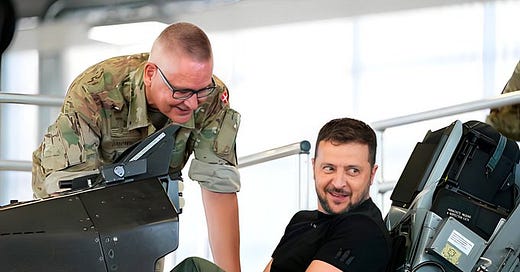


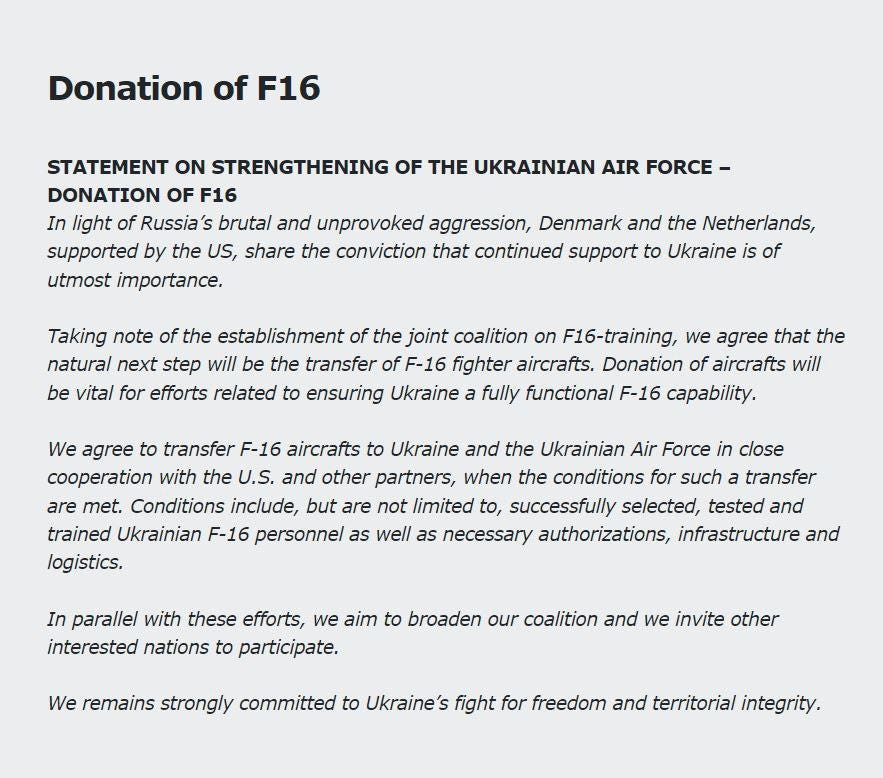
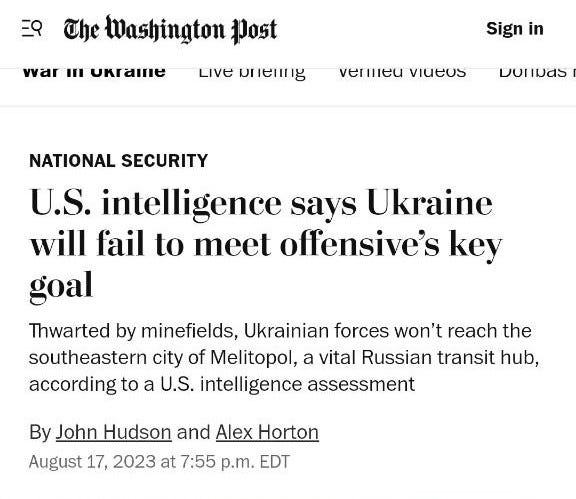
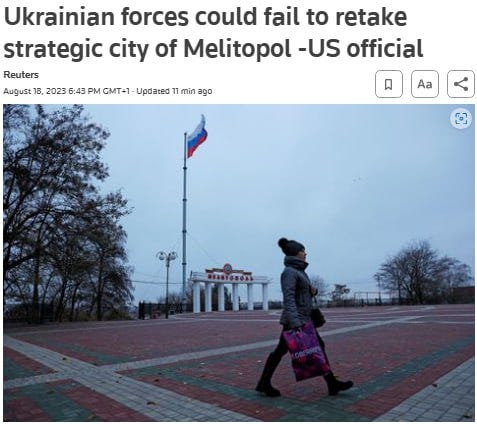

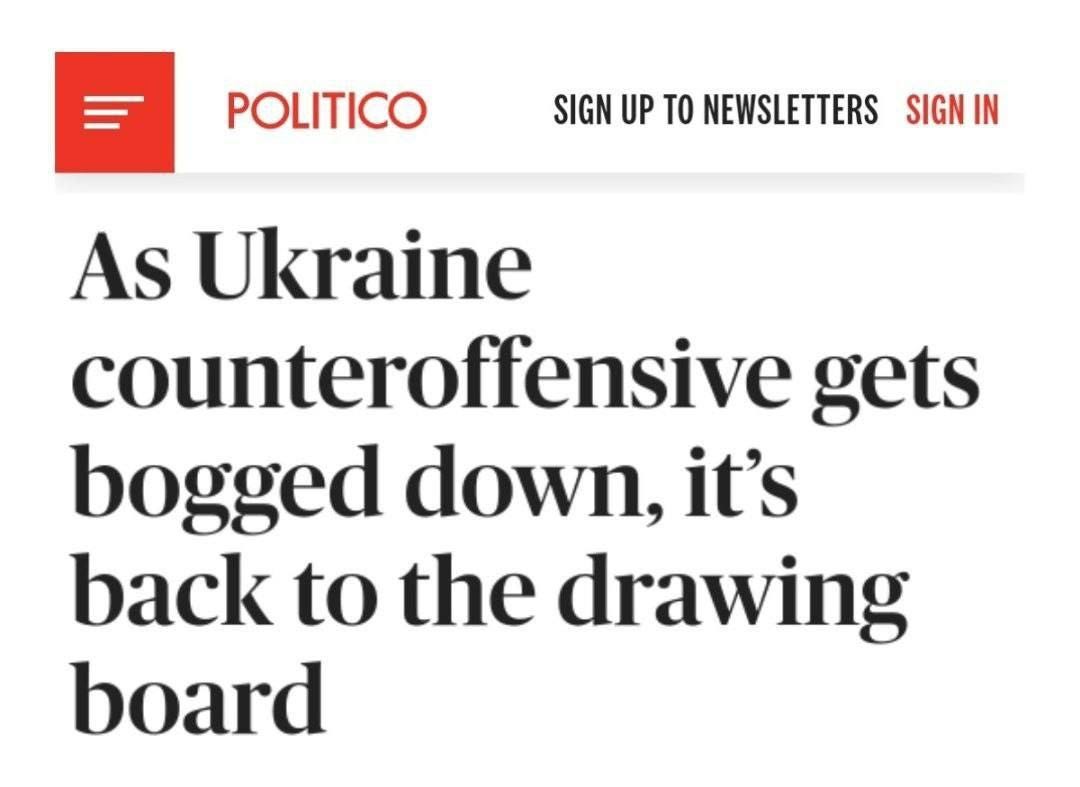

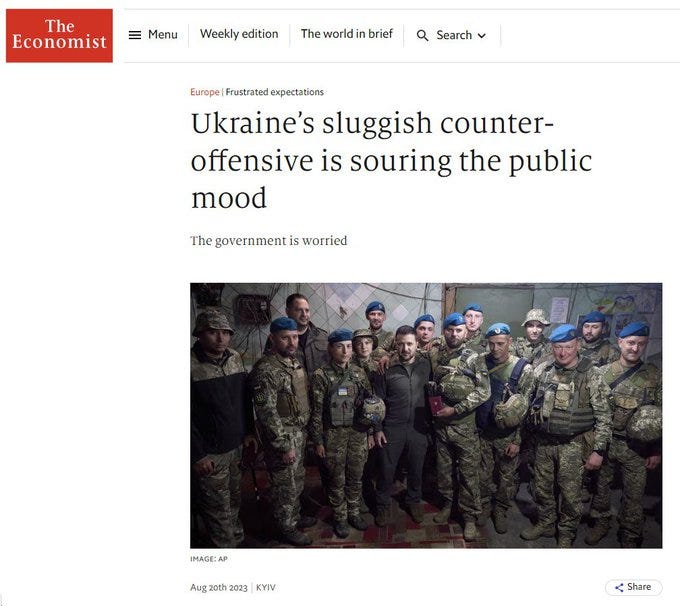
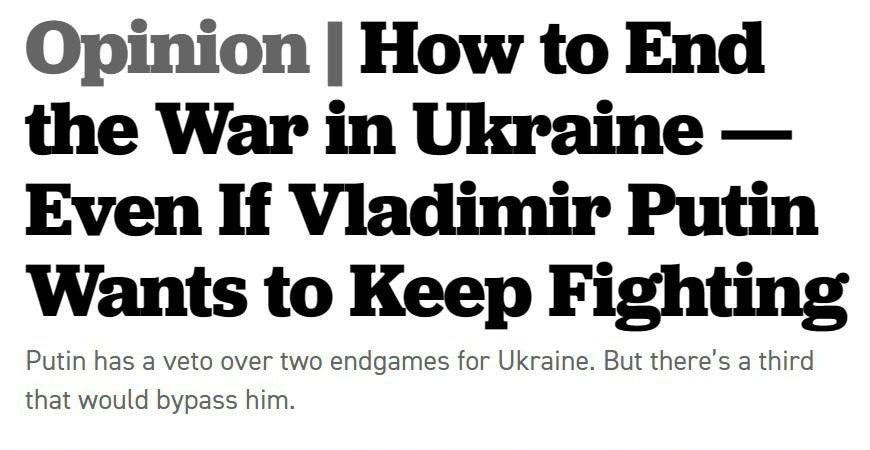



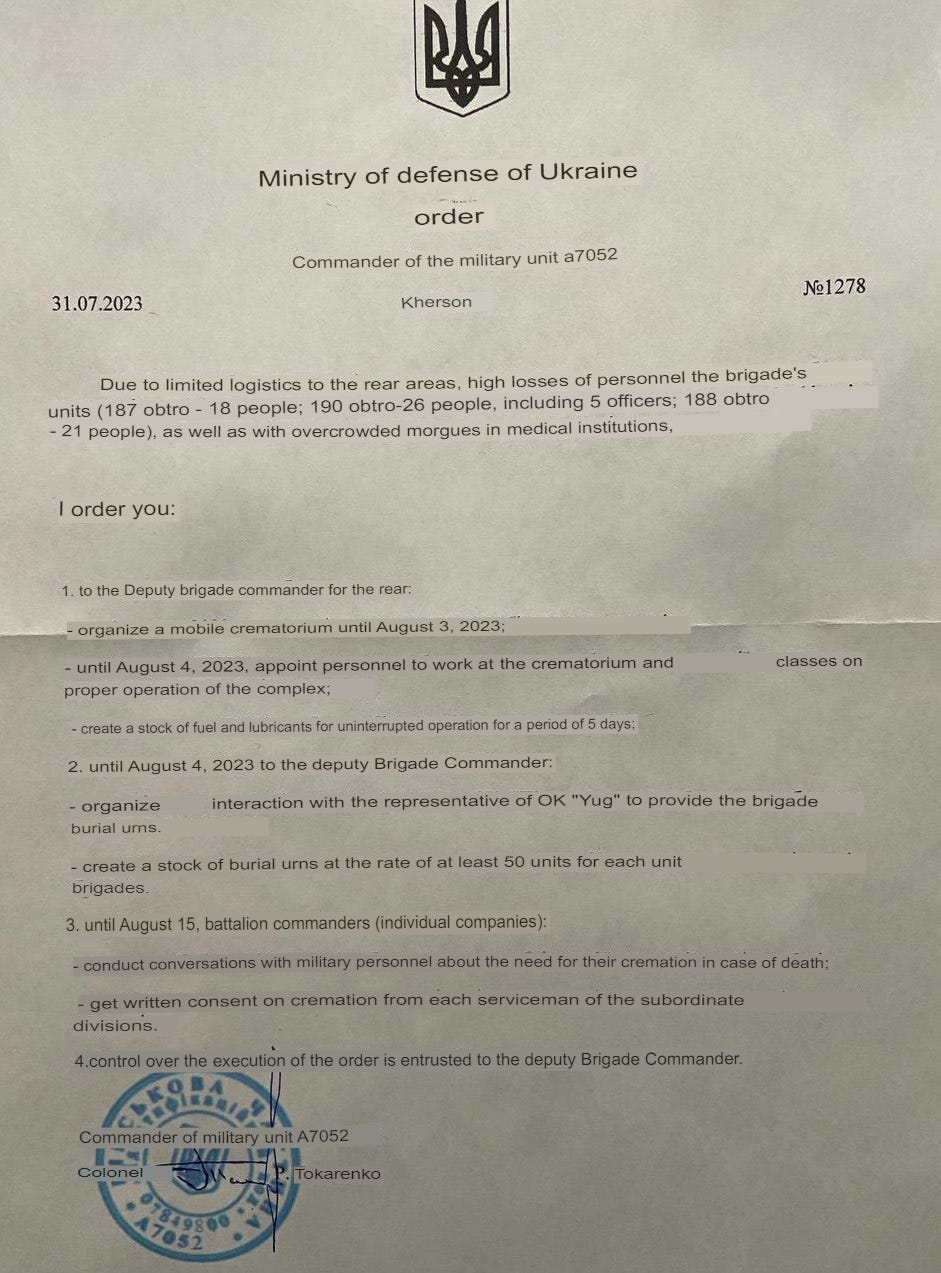
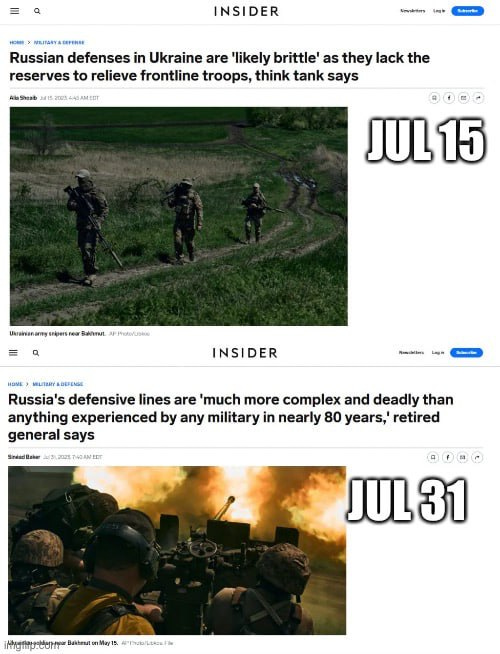

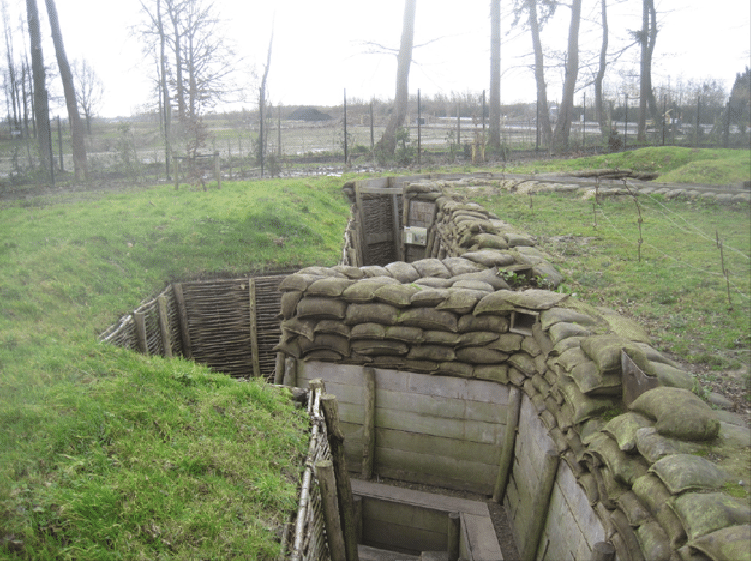
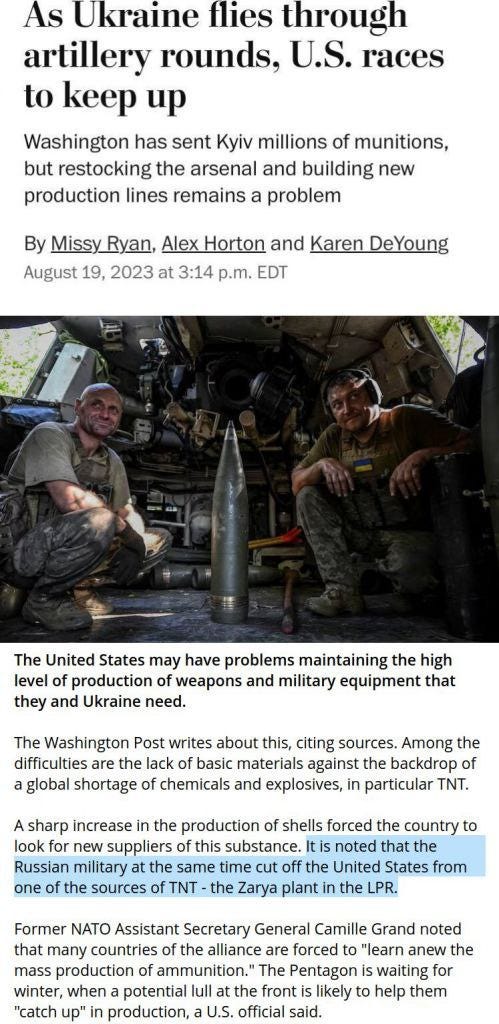

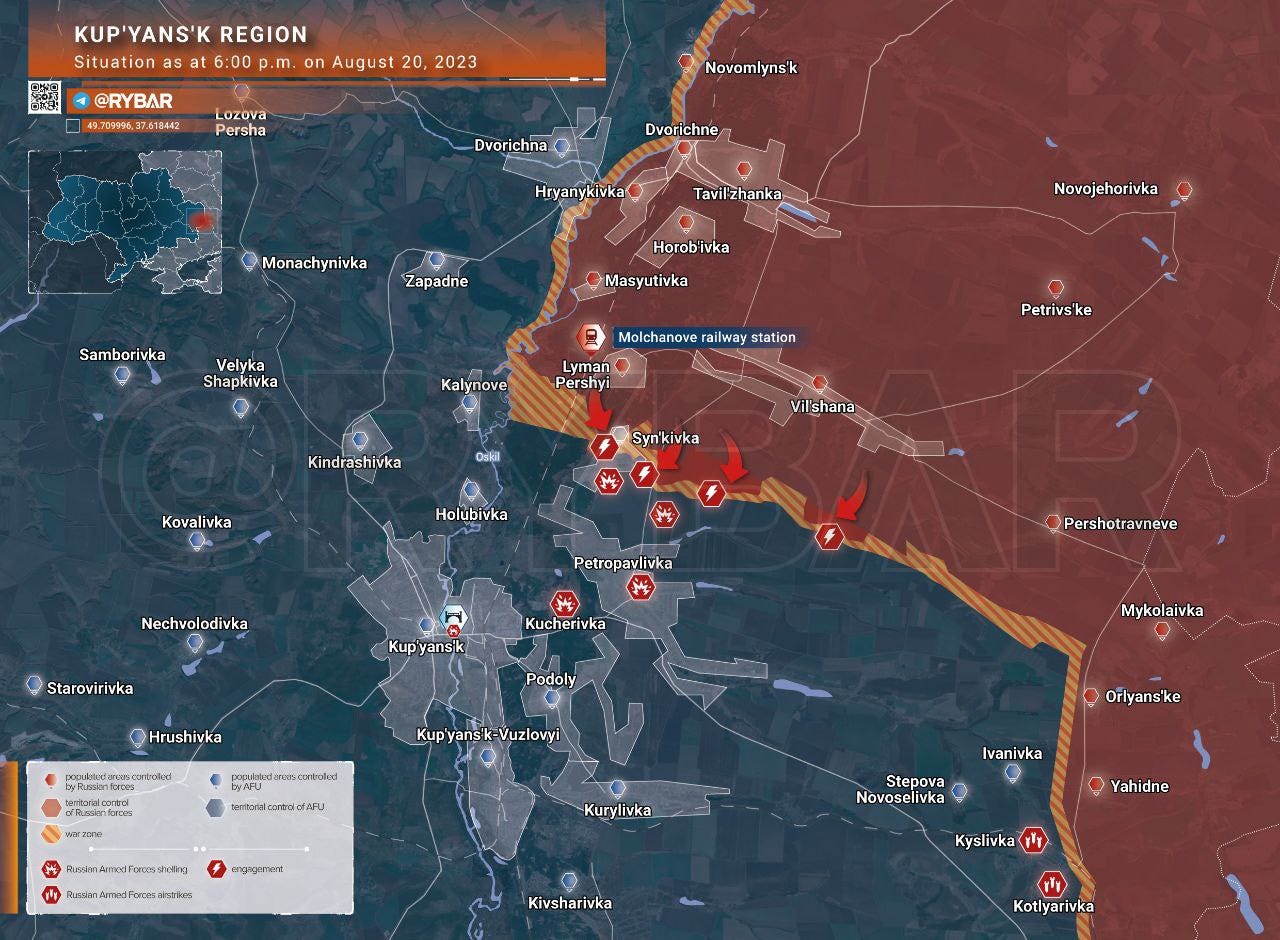
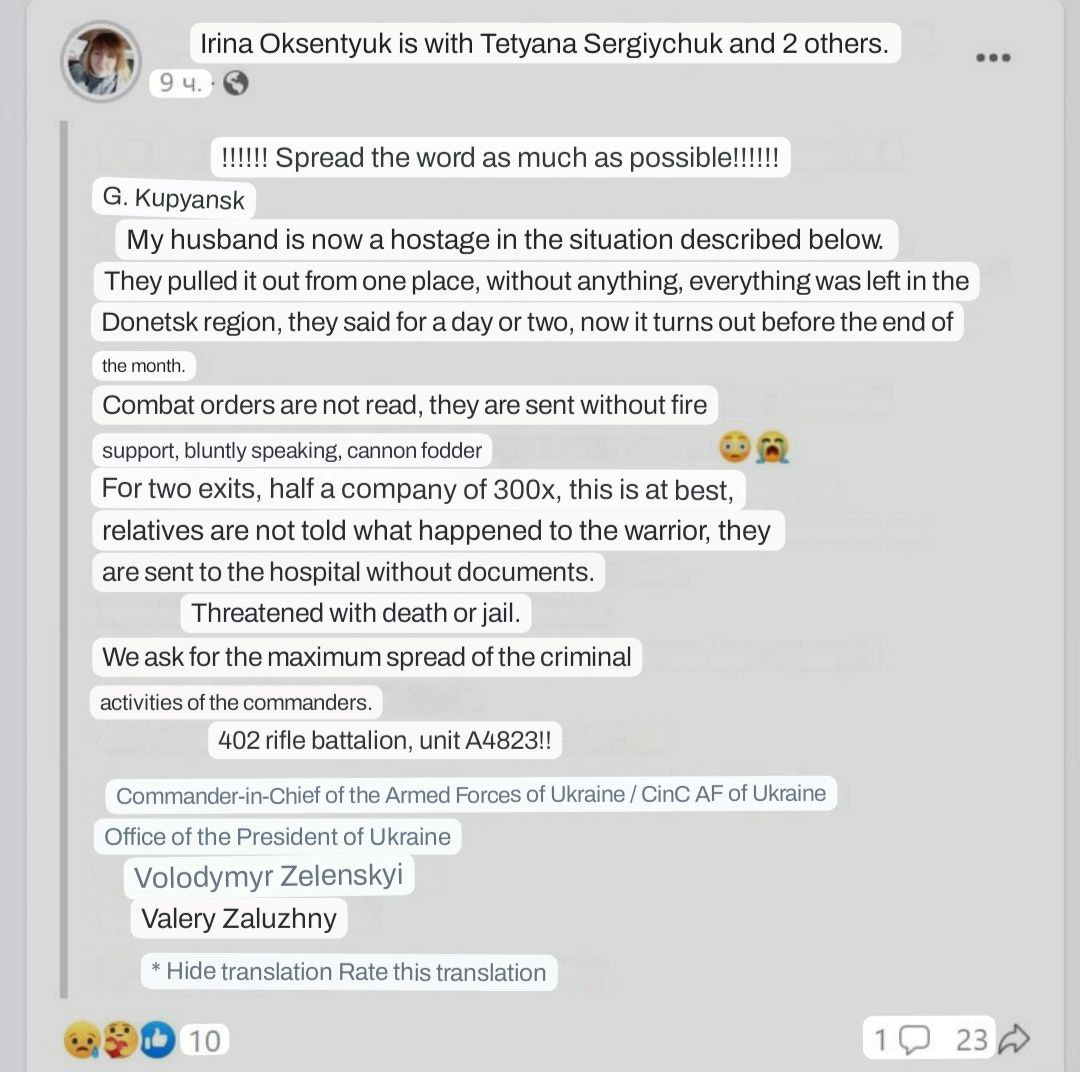






When WW1 broke out, the military commands had ideas of how the war would be fought - but nobody predicted 3 years of trench warfare on the western front
In WW2, the mighty battleship was not expected to turn into target practice for carrier borne aircraft, among other things
This WW3-lite has taught us a lot, mostly that the modern battlefield is one where you don't see much, you don't have many people around you, and you are continuously watched, day and night, from above. I honestly don't know how the soldiers on the ground handle it.
Regarding the New York Times article, of which all MSM have versions (as if ordered to), I quote:
"American officials say they fear that UKRAINE HAS BECOME CASUALTY AVERSE, one reason it has been cautious about pressing ahead with the counteroffensive."
Sure, Ukraine has less casualties because they're avoiding them! Millions of people read this shit, and are dumber for it.